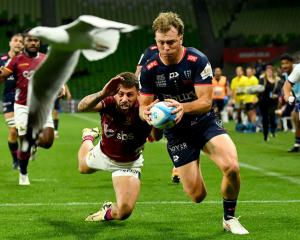Their new jersey might be the most high tech and graceful garment to be paraded on a rugby field - but it is the men inside it who will determine New Zealand's fate at the 2015 Rugby World Cup, says Richie McCaw.
The All Blacks captain swapped hitting rucks for a quick jaunt on the catwalk in Auckland today to unveil a jersey that combines the latest in modern technology with a fashionable nod to history in the form of a yoke neck that resembles the 1905 Originals jersey.
"We've got the right kit, it is about the men who are going to put it on," McCaw said.
The captain and many of the senior players had been involved in a design process that involved scanning their body movements to see how their skin stretched during a game.
"It's quite cool doing those sort of things. We did it at the end of the season. You know if you don't take interest in it then you just get given what you are given. If you are not interested then you can't really moan about it or give feedback. They give us a chance to do that and you've got to buy into it."
McCaw and his team-mates asked for something that fit well and felt comfy. Some €250 million ($NZ409 million) and two painstaking years later, their German kit manufacturers adidas unveiled a two-way woven, carbon fibre-infused garment designed to stretch in a way that mimics the players' skinfolds.
The Dynamic Stretch Analysis (DSA) technology that has gone into the jersey is used in the aerospace industry to test where aircraft wings should be reinforced, says adidas. So the chances of another Sonny Bill Williams sideline stripoff appear slim - about as slim as the chances of a would-be tackler getting hold of Ben Smith after he has ghosted through a gap.
The two-way weave is designed to stretch for comfort, but not to give when a desperate tackler tries grab a handful of shirt as an All Black flies by.
"What we've done is worked the fabric in a certain way so that the stretch is duplicating the skin stretch," said Francois Tabard, category director for rugby at adidas' HQ in Herzogenaurach, Germany.
Most senior All Blacks had visited the company's Bavarian innovation centre in recent years to undergo DSA scanning, Tabard said. Their input had been vital in producing a garment tailored to meet their every need. Forwards need something to grip onto at scrum and lineout time, so their jerseys boast proud, reinforced seams and grip panels.
That innovation came partly at the behest of the IRB (now World Rugby), which watched on in horror in 2011 as the game buried itself in a mountain of collapsed scrums that were at least partly caused by the trend towards tight-fitting, grip-resistant jerseys.
The fabric the jerseys are made out of is used in high tech sail making due to its superior strength.
Tried and tested
If this all sounds familiar - and just a little too good to be completely true - there's good reason for that.
Adidas reinvent the All Blacks jersey wheel every two years, and the iteration unveiled today is in fact the same as the one rolled out in London in November last year ahead of the All Blacks' 24-21 victory over England at Twickenham. The pre-World Cup field testing has gone well.
"One of the things we looked for in the England v New Zealand game was how the scrummaging was going to go," said adidas' director of team sports Simon Cartwright. "I think there was only one scrum that collapsed during the course of the game. It was a lot less than you would normally get and we were jumping up and down."
Reviews of the black jersey haven't always been positive, however.
The 1999 World Cup jersey - the first made by adidas - contained revolutionary grip technology on the chest to help players catch the ball.
It turned out the grippy stuff didn't perform well in the cold, and in the wet it may have even made catching the ball harder as it became slippery. It interfered with crucial sweat zones, was uncomfortable and was easier for tacklers to grab.
"I don't think it made it particularly worse because ours wasn't a fixed sheen, it was little dots," Cartwright said. "It wasn't significantly worse but it didn't bring a lot of benefit."
The players were far from impressed, Babard admitted. "It was considered more as a gimmick that a performance feature."
- By Steve Deane of the New Zealand Herald













